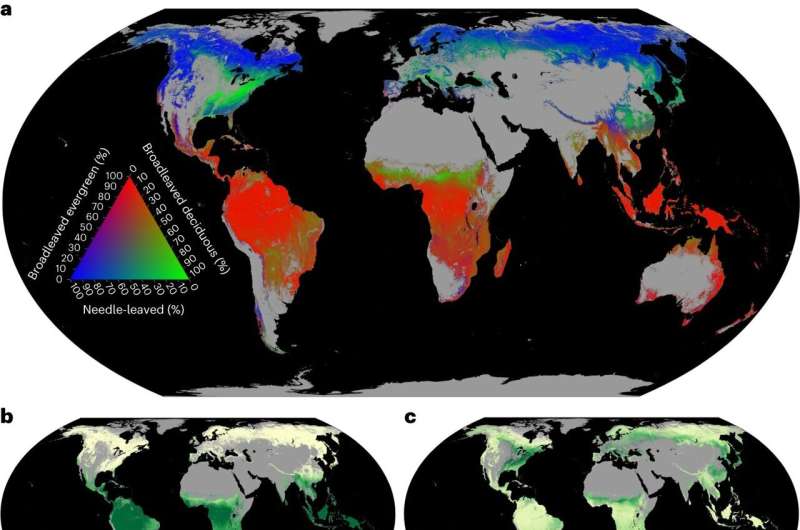This article has been reviewed according to Science X's editorial process and policies. Editors have highlighted the following attributes while ensuring the content's credibility:
fact-checked
peer-reviewed publication
trusted source
proofread
New study on the importance of tree leaves for carbon dioxide storage

In a large-scale study with almost 400 partners, researchers worldwide have collected data on tree species, to which scientists from Bayreuth have contributed their knowledge about the Kilimanjaro region. The study, which has now been published in the journal Nature Plants, improves our understanding of the different leaf types of trees and thus enables us to draw conclusions about ecosystems and the CO2 cycle.
Understanding the different leaf types of trees is crucial for understanding their role in terrestrial ecosystems, including carbon, water and nutrient dynamics. Coniferous leaves differ from deciduous leaves in their water-saving, but thereby lower biomass productivity. Deciduous trees have adapted to seasonal climatic conditions. They can grow where evergreen trees cannot, namely in areas prone to frost or drought.
"However, our knowledge of the factors that influence the foliage types of forests is still limited, so we do not know exactly how large the proportion of coniferous and foliage-bearing as well as evergreen and deciduous trees is worldwide," says PD Dr. Andreas Hemp from the Department of Plant Systematics at the University of Bayreuth.
To close this gap, almost 400 researchers worldwide have contributed data. This has resulted in a global, ground-based assessment of variation in forest leaf types by merging data from almost 10,000 forest inventory plots with records from the international Plant Trait Database TRY on leaf shape (deciduous vs. coniferous) and habit (evergreen vs. deciduous).
"We found that global variation in leaf longevity (leaf habit) depends primarily on the extent of seasonal temperature variation and soil properties, while leaf shape is primarily determined by temperature," says Hemp. For leaves to fulfill their important function in the ecosystem, these conditions must be right.
As a result of this forest inventory, the researchers assume that 38% of the global tree individuals are evergreen conifers, 29% are evergreen deciduous trees, 27% are deciduous deciduous trees and 5% are deciduous conifers. Thus, these tree types correspond to 21%, 54%, 22% and 3%, respectively, of the above-ground biomass in forests—that's between 18 and 335 gigatonnes.
"In addition, we assume that by the end of the century at least 17% and up to 38% of forested areas will be exposed to climatic conditions that currently favor a different forest type than the one currently present, which illustrates the intensification of climatic stress on trees in certain regions," Hemp points out.
"In natural forest areas, one must and can rely on nature's adaptability; in cultivated forests, as in Europe, one must sometimes think about forest conversion, which is also called for here for other reasons, for example, when one thinks of monocultures of trees. For example, when one thinks of monocultures of tree plantations with spruce that are not suited to the site."
By quantifying the distribution of tree leaf types and their corresponding biomass, and identifying regions where climate change will exert greater pressure on current leaf types, these findings will enable better predictions about the future functioning of terrestrial ecosystems and the carbon cycle.
The CO2 cycle plays an important role in the state of the atmosphere, the biosphere and thus our climate. Trees are the most important carbon sink, as they absorb and store CO2 through their leaves. Humans, on the other hand, primarily emit CO2 through the use of fossil fuels and exacerbate the development by clearing CO2-storing trees.
More information: Haozhi Ma et al, The global biogeography of tree leaf form and habit, Nature Plants (2023). DOI: 10.1038/s41477-023-01543-5
Journal information: Nature Plants
Provided by Bayreuth University

















